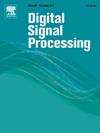Straightforward tensorized anchor graph learning for multi-view clustering
IF 2.9
3区 工程技术
Q2 ENGINEERING, ELECTRICAL & ELECTRONIC
引用次数: 0
Abstract
Even while graph-based multi-view clustering methods are quite effective in capturing the connection between data and clustering structures, the majority of them still exhibit the following limitations: (1) some methods fail to account for higher-order correlations and spatial structures between multi-view data; (2) random sampling and k-Means lead to unstable selection of anchors; (3) post-processing steps in many studies contribute to suboptimal clustering performance. To solve these issues, we propose a straightforward tensorized anchor graph learning method (STAGL) for multi-view clustering, which integrates the low-rank tensor learning and clustering into a unified framework. Specifically, we first employ a variance-based decorrelation strategy to select anchor points and construct an anchor graph for every view. Based on this, STAGL explores the similarities and spatial structures of each view by minimizing the tensor-adaptive log-determinant regularization. Additionally, we directly employ the anchor graphs to obtain the final clustering assignments by computing the distances between samples. Meanwhile, an adaptive strategy is incorporated to account for the varying importance of different views in the clustering process. Finally, we employed an efficient algorithm to solve this model, and comprehensive experiments on six datasets demonstrate the superior clustering performance of the proposed method.
多视图聚类的直接张紧锚图学习
尽管基于图的多视图聚类方法在捕获数据和聚类结构之间的联系方面非常有效,但大多数方法仍然存在以下局限性:(1)一些方法不能考虑多视图数据之间的高阶相关性和空间结构;(2)随机抽样和k均值导致锚点选择不稳定;(3)许多研究中的后处理步骤导致了次优聚类性能。为了解决这些问题,我们提出了一种直接的张紧锚图学习方法(STAGL)用于多视图聚类,该方法将低秩张量学习和聚类集成到一个统一的框架中。具体来说,我们首先采用基于方差的去相关策略来选择锚点并为每个视图构建锚图。在此基础上,STAGL通过最小化张量自适应对数行列式正则化来探索每个视图的相似性和空间结构。此外,我们直接使用锚图通过计算样本之间的距离来获得最终的聚类分配。同时,采用自适应策略来考虑不同视图在聚类过程中的不同重要性。最后,我们采用了一种高效的算法来求解该模型,并在6个数据集上进行了综合实验,证明了该方法具有优异的聚类性能。
本文章由计算机程序翻译,如有差异,请以英文原文为准。
求助全文
约1分钟内获得全文
求助全文
来源期刊

Digital Signal Processing
工程技术-工程:电子与电气
CiteScore
5.30
自引率
17.20%
发文量
435
审稿时长
66 days
期刊介绍:
Digital Signal Processing: A Review Journal is one of the oldest and most established journals in the field of signal processing yet it aims to be the most innovative. The Journal invites top quality research articles at the frontiers of research in all aspects of signal processing. Our objective is to provide a platform for the publication of ground-breaking research in signal processing with both academic and industrial appeal.
The journal has a special emphasis on statistical signal processing methodology such as Bayesian signal processing, and encourages articles on emerging applications of signal processing such as:
• big data• machine learning• internet of things• information security• systems biology and computational biology,• financial time series analysis,• autonomous vehicles,• quantum computing,• neuromorphic engineering,• human-computer interaction and intelligent user interfaces,• environmental signal processing,• geophysical signal processing including seismic signal processing,• chemioinformatics and bioinformatics,• audio, visual and performance arts,• disaster management and prevention,• renewable energy,
 求助内容:
求助内容: 应助结果提醒方式:
应助结果提醒方式:


